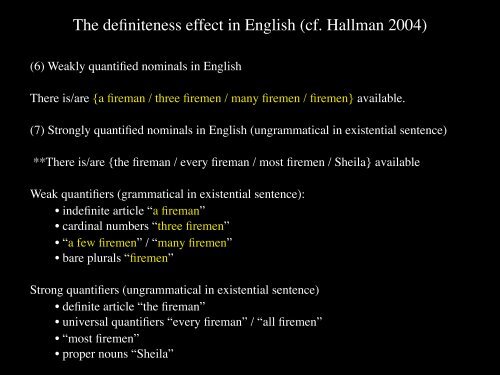Internally Headed Relative Clauses in Akkadian - Cuneiform Digital ...
Internally Headed Relative Clauses in Akkadian - Cuneiform Digital ...
Internally Headed Relative Clauses in Akkadian - Cuneiform Digital ...
You also want an ePaper? Increase the reach of your titles
YUMPU automatically turns print PDFs into web optimized ePapers that Google loves.
The def<strong>in</strong>iteness effect <strong>in</strong> English (cf. Hallman 2004)<br />
(6) Weakly quantified nom<strong>in</strong>als <strong>in</strong> English<br />
There is/are {a fireman / three firemen / many firemen / firemen} available.<br />
(7) Strongly quantified nom<strong>in</strong>als <strong>in</strong> English (ungrammatical <strong>in</strong> existential sentence)<br />
**There is/are {the fireman / every fireman / most firemen / Sheila} available<br />
Weak quantifiers (grammatical <strong>in</strong> existential sentence):<br />
• <strong>in</strong>def<strong>in</strong>ite article “a fireman”<br />
• card<strong>in</strong>al numbers “three firemen”<br />
• “a few firemen” / “many firemen”<br />
• bare plurals “firemen”<br />
Strong quantifiers (ungrammatical <strong>in</strong> existential sentence)<br />
• def<strong>in</strong>ite article “the fireman”<br />
• universal quantifiers “every fireman” / “all firemen”<br />
• “most firemen”<br />
• proper nouns “Sheila”
















